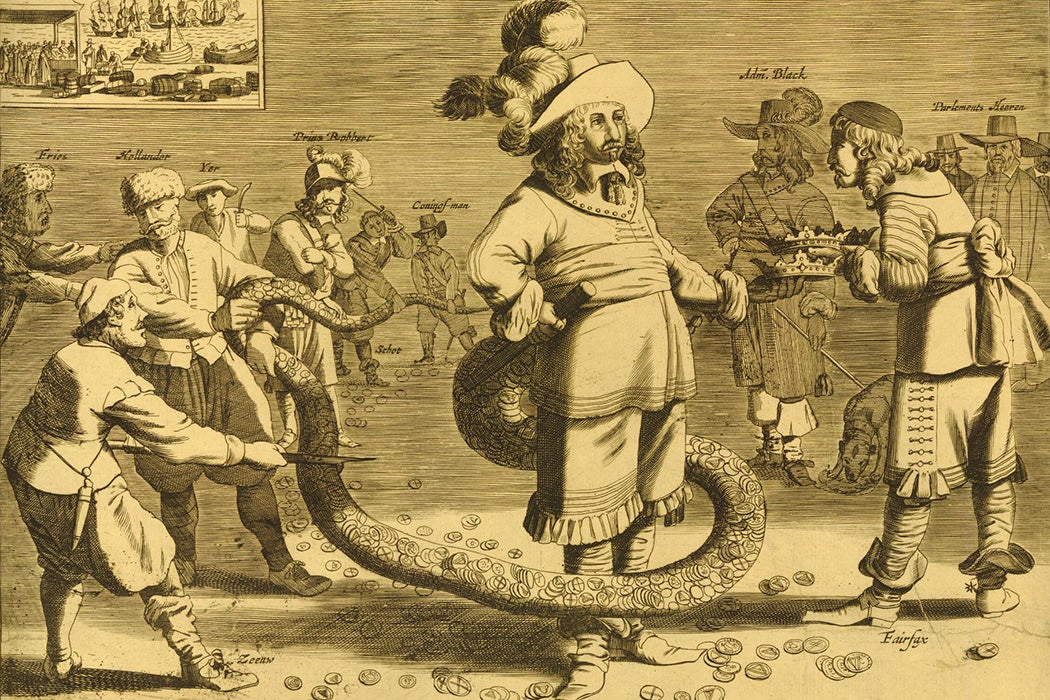“Tails, tails!” That was the taunt the people of Paris flung at the English army in 1436 as the soldiers vacated the city that they had occupied for sixteen years.
It was common knowledge among Parisians that each English person, under their clothes, concealed a secret tail. Beginning in the twelfth century, writes art historian Lilian M. C. Randall, French literature was peppered with references to this hidden appendage—and the story soon spread. In his history of the taunt written the end of the nineteenth century, George Neilson argued that the Scottish boasted before a skirmish in 1332 that they would “make ropes of the tails of the English to tie them with.” An Italian book of the fourteenth century also described England as an island whose inhabitants were born with short tails, like deer.
But it didn’t stop there. The “tails” taunt naturally suggested comparisons to slippery eels, venomous snakes, filthy rats, and so on. And by an odd leap—a similarity between the French words coue (tail) and couve (hatch)—it seems to have given rise to a bizarre stereotype about English people sitting on eggs; Flemish poems of the 1200s mockingly recommend that, if you lack hens, you ought to call in an Englishman to squat over your nests, writes Randall.
Where did this all start? It seems that the slander was first applied just to the people of Kent. According to Neilson, St. Augustine tried to proselytize there and was mocked by the locals. They pinned rays’ tails to his robes, and in return, were cursed with tails of their own.
Weekly Newsletter
Another version of the story deals with St. Thomas à Becket. As recorded by Sabine Baring-Gould in 1867, Renaissance-era historian Polydore Vergil wrote that when Becket
came to Strood, which village is situated on the Medway, the river that washes Rochester, the inhabitants of the place, being eager to show some mark of contumely to the prelate in his disgrace, did not scruple to cut off the tail of the horse on which he was riding; but by this profane and inhospitable act they covered themselves with eternal reproach; for it so happened after this, by the will of God, that all the offspring born from the men who had done this thing, were born with tails, like brute animals.
Conflated and exaggerated over time, the legends of the tail curse came eventually to encompass all English people. And, as it went on, the divine retribution element dropped away, and tailed-ness came to stand as a sign that the English were closer to beasthood than other peoples, or as an indication of affinity with the Devil.
By the sixteenth century, the teasing seems to have grown unbearable. As recorded by Neilson, the Bishop of Ossory John Bale claimed that
an Englyshman now can not travayle in an other lande by waye of merchandyce or anye other honest occupyenge but yt ys most contumelyouslye throwe in his tethe that all Englyshmen have tayles.
And, though most of the taunts focused on Englishmen, women did not escape, as witnessed by this bit of anonymous doggerel:
Do but look at a dame of degree
Her tail of two ells long you’ll see
—A skirt like what beasts bear behind!
No wonder in fright if you fly
The reason’s too obvious why
Ev’n her lord deems her death not unkind.
During the Anglo-Dutch Wars, the stereotype proved a major boon to propagandists, notes Elizabeth Staffell. Oliver Cromwell’s tail waggled its way across the Dutch prints of the era, sometimes slithering and serpentine, sometimes fluffy and foxlike. One image shows a famous English general raising his tail—a leonine puff—to expel a fleet of ships.
It seems odd that something that was “common knowledge” for at least four hundred years could vanish so completely. But in fact, though the idea of the tailed Englishman faded from prominence, it never really disappeared. Baring-Gould remembered, as a child, asking a Cornish neighbor about his tail. Upon being told he didn’t have one, he says “I satisfied my own mind that the good man had sat his off, and my nurse assured me that such was the case with those of sedentary habits.” And in 2020, a Reddit user recalled, “My Irish grandmother always claimed that Englishmen had tails. She was quite insistent about it.”
Support JSTOR Daily! Join our membership program on Patreon today.







